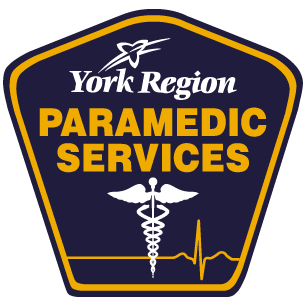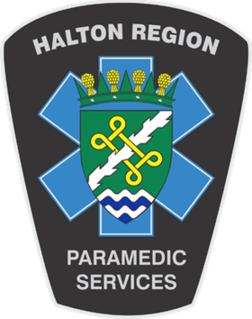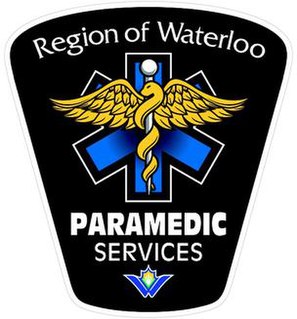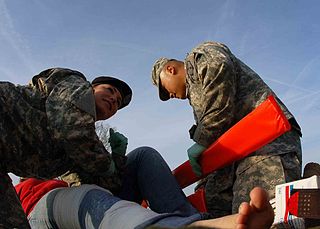
A paramedic is a health care professional whose primary role is to provide advanced emergency medical care for critical and emergent patients who access the emergency medical system.
A medical director is a physician who provides guidance and leadership on the use of medicine in a healthcare organization. These include the emergency medical services, hospital departments, blood banks, clinical teaching services and others. A medical director devises the protocols and guidelines for the clinical staff and evaluates them while they are in use.

A paramedic is a healthcare professional, providing pre-hospital assessment and medical care to people with acute illnesses or injuries. In Canada, the title paramedic generally refers to those who work on land ambulances or air ambulances providing paramedic services. Paramedics are increasingly being utilized in hospitals, emergency rooms, clinics and community health care services by providing care in collaboration with registered nurses, registered/licensed practical nurses and registered respiratory therapists.

In the United States, the paramedic is a professional whose primary focus is to provide advanced emergency medical care for critical and emergency patients who access Emergency Medical Services (EMS). This individual possesses the complex knowledge and skills necessary to provide patient care and transportation. Paramedics function as part of a comprehensive EMS response, under medical oversight. Paramedics perform interventions with the basic and advanced equipment typically found on an ambulance. The paramedic is a link from the scene into the health care system. One of the eligibility requirements for state certification or licensure requires successful completion of a nationally accredited Paramedic program at the certificate or associate degree level. Each state varies in requirements to practice as a paramedic, and not all states require licensure.

A paramedic in Australia is a health care professional who responds to and treats all types of medical and trauma emergencies outside of a hospital setting before and during transportation to an appropriate medical facility. Paramedics also work in the inter-facility transport environment where a paramedic will continue or upgrade medical care to a higher level while transporting a patient from one healthcare facility to another. Paramedics are able to treat patients in the pre-hospital setting, and can transport them to a hospital-based emergency department if deemed necessary. A new paramedic is evolving, the Paramedic Practitioner. The Paramedic Practitioner provides primary health care in a range of health settings and forms part of a multidisciplinary medical team. In Australia, use of the term paramedic is lawfully restricted to the use of those registered with AHPRA.
Paraprofessional is a title given to individuals in various occupational fields, such as education, healthcare, engineering, and law. Historically, paraprofessionals assisted the master professional of their field. In more recent times, paraprofessionals have become a professional in their own right, providing services which meet the needs of a particular recipient or community.

York Region Paramedic Services provides legislated land ambulance services and paramedic care for the local municipalities within York Region. Paramedic Services is a division of the Region's Paramedic and Seniors Service Branch. Prior to 2000, ambulance services were provided by 2 private operators, York County Hospital, Nobleton Volunteer Ambulance and Ontario's Ministry of Health. The patchwork of service also had York Region dispatched by 3 different Ministry of Health Communication Centres. Georgian CACC now dispatches the whole region on the Ontario Government leased Bell Mobility Fleetnet VHF trunked radio system. There are approximately 480 full-time paramedics serving the region. Paramedic Operations are based in East Gwillimbury, Ontario.
Region of Durham Paramedic Service provides emergency medical services to Durham Region in Ontario, Canada.

Halton Region Paramedic Services provides emergency medical services to the municipalities of Halton Region:

Hamilton Paramedic Service is the designated service provider for emergency medical services (ambulance) in the City of Hamilton, Ontario.

Region of Waterloo Paramedic Services is an emergency medical service provider for the Regional Municipality of Waterloo. The service provides both advanced and primary care level paramedic services to Waterloo, Ontario, Cambridge, Ontario and Kitchener, Ontario and the townships of Wilmot, Woolwich, Wellesley and North Dumfries.

Emergency medical personnel in the United Kingdom are people engaged in the provision of emergency medical services. This includes paramedics, emergency medical technicians and emergency care assistants. 'Paramedic' is a protected title, strictly regulated by the Health and Care Professions Council, although there is tendency for the public to use this term when referring to any member of ambulance staff.
In the US, paramedicine is the physician-directed practice of medicine, often viewed as the intersection of health care, public health, and public safety. While discussed for many years, the concept of paramedicine was first formally described in the EMS Agenda for the Future. Paramedicine represents an expansion of the traditional notion of emergency medical services as simply an emergency response system. Paramedicine is the totality of the roles and responsibilities of individuals trained and credentialed as EMS practitioners. These practitioners have been referred to as various levels of Emergency Medical Technician (EMTs). In the United States paramedics represent the highest practitioner level in this domain. Additional practitioner levels in this domain within the U.S. include Emergency Medical Responders (EMRs), Emergency Medical Technicians (EMTs) and Advanced Emergency Medical Technicians (AEMTs).
An Emergency Care Practitioner (ECP) generally come from a background in paramedicine and most have additional academic qualifications, usually at university, with enhanced skills in medical assessment and extra clinical skills over and above those of a standard paramedic, qualified nurse or other ambulance crew such as EMT's and Ambulance Technicians. It has been recommended by the College of Paramedics and Department of Emergency medical care in universities that ECPs be trained to PgDip or MSc level, although not all are. Evidence of the best way to target Emergency Care Practitioners is limited with utilisation of traditional Ambulance dispatch codes not always being shown to be most effective and referrals from GPs also potentially failing to deliver management of demand that would be appropriate for this different level of practitioner. Evidence however clearly demonstrates that in discreet groups of patients the use of these extended role staff responding to emergency calls can reduce admissions and thus improve patient outcomes as well as delivering a clear cost saving to the NHS.

Emergency medical responders are people who are specially trained to provide out-of-hospital care in medical emergencies. There are many different types of emergency medical responders, each with different levels of training, ranging from first aid and basic life support. Emergency medical responders have a very limited scope of practice and have the least amount of comprehensive education, clinical experience or clinical skills of emergency medical services (EMS) personnel. The EMR program is not intended to replace the roles of emergency medical technicians or paramedics and their wide range of specialties. Emergency medical responders typically assist in rural regions providing basic life support where pre-hospital health professionals are not available due to limited resources or infrastructure.

Peel Regional Paramedic Services, provide ambulatory and paramedic care for the municipalities within Peel Region, in Ontario, Canada. Paramedic Headquarters are located in Brampton at 1600 Bovaird Road east and operations serve the residents of Caledon, Brampton, and Mississauga.
Emergency medical services in Australia are provided by state ambulance services, which are a division of each state or territorial government, and by St John Ambulance in both Western Australia and the Northern Territory.
The Manitoba Emergency Services College (MESC) is an emergency services training facility located in Brandon, Manitoba. It offers educational programs for current or potential firefighters and paramedics.

After the Sirens is a 2018 Canadian documentary television program about the epidemic of post-traumatic stress disorder among paramedics. It consists of interviews with emergency medical workers and mental health experts as well as dramatic re-creations of emergency calls experienced by the interview subjects. It was directed by Kevin Eastwood and produced and commissioned by the Canadian Broadcasting Corporation for the Docs POV television program.










